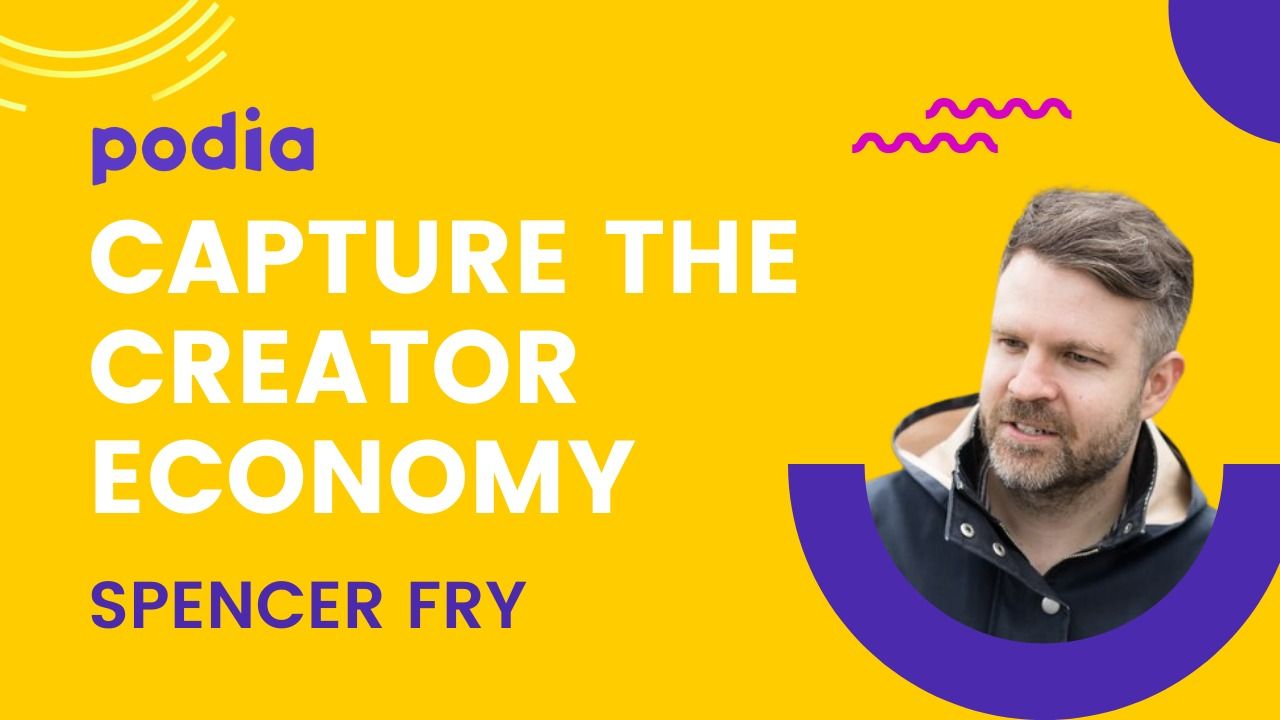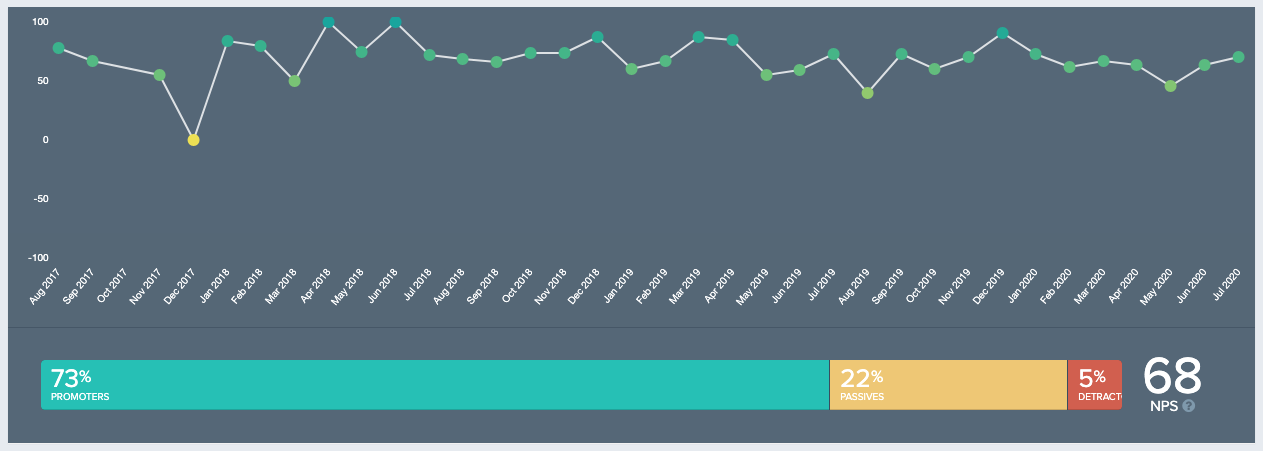How to capture the creator economy | Podia 🎨

“Faster iterations coupled with perseverance is the best route to have a successful product -- not sleek designs or scalable code.”
👆 That’s Spencer Fry’s number 1 insight after running multiple successful startups over the last 19 years.
Spencer is the founder of Podia - A platform that helps creators sell digital products, courses, webinars, and even host communities.
Spencer started Podia in 2014, it was his first business that he ever raised VC money for. 5 years in, by 2020, Podia was profitable.
Podia doesn’t disclose its revenue numbers publicly, but it’s safe to say that it’s a multi-million dollar company today, with a team of around 30 people.
The reason for Podia’s success is Spencer’s spirit of perseverance and iteration. And his obsession with customer research.
So much so that just in 1 year he spoke to 4000 people over live chat, webinars, and video calls.
This customer obsession manifests in the form of extremely high NPS (Net Promoter Score).

(source)
NPS is a measure of how many of your customers are your staunch promoters.
An NPS of 68 puts Podia in the top 0.01% of all companies. (Right up there with Apple!)
They are clearly the OGs in the crowded creator economy space.
There’s plenty to learn from the success of Podia 👇
Podia: The Product 🧑🏫
Podia’s tagline reads: “Everything you need to sell courses, webinars, downloads, and community.”
It captures the entire spectrum of how a modern-day creator makes a living online. Podia started as a course selling platform back in 2014.
It has a cool origin story: Spencer’s father, Paul Fry is a Yale professor, he taught one of the first-ever online courses back in 2009. It has been viewed millions of times on YouTube since then.
Spencer realized the potential of online courses back then.
But he had a unique take on it, something more than just free YouTube videos.
Eventually in 2014, with a vision to democratize online courses, he started Podia.
The MVP was very basic, it had roughly 3 features:
- A way for creators to accept payments
- Upload content
- And a way to maintain a customer list.
That’s it.
You don’t need many features to get started. You need just enough for your ideal customers to start using the product and giving you feedback.
Customer Focus 🔍
Spencer built the product with extreme customer focus right from the start. He has had thousands of customer conversations by now.
And even does 1 live product demo every week himself, just so he can be close to his customers.
Check out the product demo page on Podia’s website, he hosts a session every Tuesday at 2 PM ET.
Spencer has built a solid framework for customer research.
Reaching out to customers to book a call, interviewing them, taking notes, and then transferring those insights into features.
Back in 2015, he used to send out 10 emails a day to customers for an interview, with a personalized message to everyone, and from his personal email id.
Then he would get on calls and ask them about their experience of using the platform. (Back then Podia was called “Coach”).
The 4 most effective questions that gave him the best insights to grow:
- What did you expect would happen when you signed up for Coach?
- What actually happened when you signed up?
- Help me understand what benefit you want to get out of Coach.
- If you could wave a magic wand and do anything on Coach, what would it be?
These questions hone in on the quickest “aha” moments you can give to your customers, in the short term as well as in the long term.
Raising Funds vs Bootstrapping 💰
Before Podia, Spencer had bootstrapped and sold 3 startups. But for his fourth one, he went the VC-funded way.
He had started Podia with $30K of his own money and built the product out with the help of a contractor.
For the 1st year, Podia could only reach $4K MRR and half a dozen customers.
To scale, Spencer needed a team, and for that, he needed more money. That’s why he raised $500K back in late 2015.
Then in 2017 Podia raised $1.6M and another $1M in March 2019.
(source: Crunchbase)
By 2020, Podia became profitable, the contractor who started with Spencer eventually became the CTO of the company - Jamie Lawrence
And the team has grown to 30 people by now.
If Spencer had bootstrapped it might have been very hard to grow so much in a span of 5 years.
Do read Spencer’s thread about reaching profitability:
Podia hit profitability this year. 🤑📈
— Spencer Fry (@spencerfry) July 13, 2020
Here’s how we built @podia into a profitable company.
A thread 👇
Profitability gives the Podia team the confidence and financial stability to keep executing their vision.
Raising funds from the start helped Spencer play the long-term game and remain unprofitable for years.
That would have been near impossible to do as a bootstrapper.
Unique positioning in a crowded space 1️⃣
The creator economy is a crowded space.
So many SaaS tools and platforms are targeting creators as their users and looking to help them grow their businesses.
While every other platform positions itself focused on 1 or 2 primary features, Podia positions itself as an all-in-one tool for creators.
Here’s how Podia differentiates itself from its competitors:
- Gumroad is focused on digital downloads.
- Teachable and Thinkific are focused on online courses.
- ConvertKit is focused on email marketing.
- Circle and MightyNetworks are focused on hosting communities.
Podia does all of it!
And adds more features like:
- Site builder.
- Affiliate marketing
- On-page live chat that creators can offer to their audience.
The big bet that Podia is taking is that in the future creators will prefer an all-in-one tool over single feature tools.
And that comes out clearly in its messaging.
The sub-headline on Podia’s home page reads: “Never worry about getting a bunch of different tools to “talk to each other” again.”
And the tagline on Podia’s pricing page aptly reads: “Get the power of 5+ tools for the price of one.”
Podia’s Ideal Users 🙋
For creators just starting out, Podia’s offerings may be overkill.
But for a mature creator, it makes a lot of sense to go with Podia and skip all the other platforms.
Gumroad helps creators make their 1st dollar online, it’s often the 1st SaaS product that creators use to monetize their creations.
But Podia helps them run their entire business in 1 place. It might be the final SaaS product creators use.
Mature creators, with large audiences, can bring in way more revenue (and profits) than newbie creators just starting out.
They are Podia’s ideal users.
And that’s why I think Podia is well on its way to capturing the creator economy.
User feedback from the wild 🌳
Indie Hacker Arvid Kahl recently launched his course “Find Your Following” on both Podia and Gumroad.
Before this course, his books were available only on Gumroad and Amazon. This is the 1st time he’s using Podia.
I asked him -
- As a user of both Gumroad and Podia, which product solves which problem for him?
- Why did he go with Podia also this time, not just Gumroad?
- And did he think of other platforms like Maven or Teachable?
This is what Arvid had to say:
“I wanted to see what people prefer. I now see that they have a huge preference for Gumroad over Podia. Gumroad allows me full control over every file. Podia looks nice and has solid video streaming.”
“And yes, I thought about Maven (but that's for cohort courses). Didn't think much about Teachable.”
It’s interesting to note, at the time of writing, Arvid’s course is available on 2 more platforms: Udemy and SkillShare.
Mature creators like Arvid might be Podia’s ideal users, but they are also smart enough to diversify their channels and hedge against platform risk.
As Yaro pointed out to me on Twitter, creators going all-in on Podia may suffer from platform risk -
Interesting point here but what I’d Podia shuts down? Seems it’s a big risk for a creator potentially. I think Gumroad is a great place for new creators but end game might not be so black and white. I’d rather pick and choose the best rather than pick one platform for everything.
— Yaro Bagriy (@yarobagriy) February 17, 2022
I agree with Yaro, it’s not as black and white.
And I think smart creators will always hedge their risks. (We know Arvid’s doing that)
But it’s important to note that, unlike social media platforms, with SaaS tools, creators own the relationship with their audience.
They have them on the email list, they interface with their audience on multiple social media platforms.
Often on a daily basis.
So platform risk isn’t as grave as it may sound in this case.
A note on going broad vs niching down ✏️
It’s good to note here that a funded startup with a large team can have a bold vision like that. Most bootstrapped founders are better off niching down on 1 or 2 features, and finding an edge there.
Even Spencer himself started out with minimal features when he was self-funded.
It can also be the pressure of VC funding that has forced Podia to offer so many features, in a bid to capture the entire market.
Because that’s what investors want.
Indie Hackers don’t need to capture the entire market. They can focus on a small segment and find their niche.
AJ of Carrd did this brilliantly, started with a limited set of features, found success, and then raised funds much later for strategic reasons. (read more about Carrd here)
Spencer’s Advice 🤗
Spencer’s advice to aspiring indie hackers is to stay persistent and keep iterating:
“Persistence and iteration are the most important thing ever. Continue to improve, get better every single day, continue to educate yourself.”
An excerpt from his blog:
“I truly believe that on the internet, given enough time, care, and hard work, you can be successful in what you set out to do. If your goal is to build a self-sustaining SaaS business, you can do that, but you can’t do that if you give up too early.”
Read more about this in his blog post: Perseverance pays off
Thank you for reading 🙏
I hope Podia’s success inspires you to build your own startup with a bold vision.
Continue reading to learn key lessons from Podia’s success.
You will learn:
- How Podia managed to get 1.5M+ backlinks to boost its SEO game.
- How Podia is beating 48 competitors with 1 strategy.
- How did Spencer Fry achieve “Founder Market Fit”?
- And how you can enter the "online course economy"?
Also, you will learn Podia’s :
- Growth Strategies📈
- Actionable Insights📊
- Traffic Channels🔢
- Landing Page Lessons📃
- Related Trends and Opportunities💸
Read on -
Related Links 🔗
- Hard-Learned Lessons from Decades of Entrepreneurship with Spencer Fry of Podia | Indie Hackers podcast #233
- 4x founder, 3 exits — currently building Podia, an OG in the creator economy since 2014, AMA! | Spencer’s Indie Hackers AMA
- Perseverance pays off | Spencer Fry
More startups leveraging the creator economy 🤝
- How to reach $4.2M ARR while pursuing a mission | Ghost👻
- Rock Bottom To Rocket Ship🚀 | How Veed Grew To $5M+ ARR
- 0 To 28M ARR While Building In Public📈 | Nathan Barry | ConvertKit
- Indie Hacker on the Unicorn Track🦄 | Riverside
Startups that have benefitted from customer conversations🗣️
Thank you for reading🙏
I hope you found value in this post, would love to get some feedback about the newsletter from you.
If you have 2 minutes please answer these 3 simple questions.
Every week, I share the most actionable insights and inspiring tips from successful Indie Hackers FOR aspiring Indie Hackers
Ideas + Insights + Inspiration for building profitable internet businesses💪
Sign up to Listen Up! IH and join 1800+ spirited Indie Hackers who read this newsletter every week.
Cheers,

